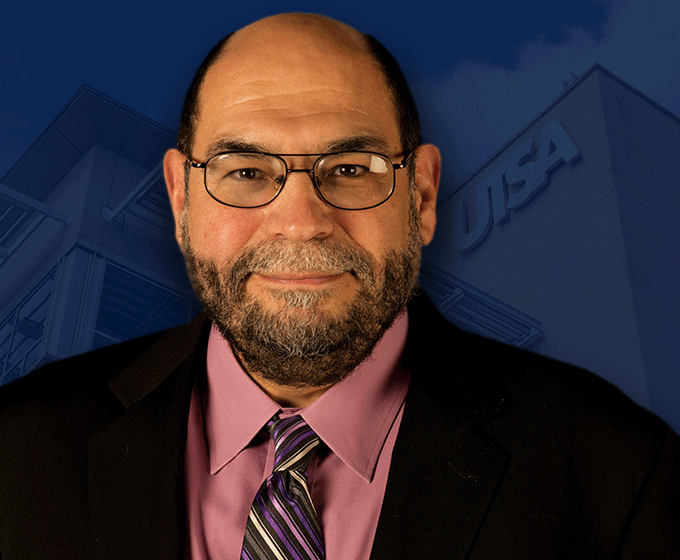
OCTOBER 18, 2021 — As part of Hispanic Heritage Month, UTSA Today interviewed Rogelio Sáenz, an author and professor of demography in the UTSA College for Health, Community and Policy. Sáenz’s research expertise includes addressing the grand challenges of underrepresented populations, including Latino people, Black people and other people of color.
UTSA Today connected with Sáenz and asked him about his latest project.
You recently published a public policy brief regarding the inequities in job recovery during the COVID-19 pandemic. What motivated you to focus on a particular segment of the population?
In April 2020, after the first two months of significant spread of COVID-19 in the United States, nearly 25 million fewer people had a job. In June 2021, there were still 5.9 million fewer people employed, representing a 3.7% drop of workers since before COVID. I formed a great research collaboration with my colleague, Corey Sparks, associate professor of demography, as well as with Asiya Validova, a doctoral student in our department, to shed light on this important issue.
The three of us analyzed the groups in which the jobless rates remain higher—focusing on the groups that have historically suffered disparities in the workforce, including persons of color, women and immigrants.
What can you tell us about the findings of your research?
Our research findings showed that jobless rates for all groups remain higher than they were prior to the pandemic. Although there have been significant improvements in the number of individuals holding a job since the unemployment spike in April 2020, the full employment panorama shows that the number of people who are unemployed soared 59% between February 2020 and June 2021, and participation in the civilian labor force plunged by 2.1 million persons, a drop of 1.3% during this period.
All told, the nation’s unemployment rate stood at 6.2% in June 2021, compared to 3.9% in February 2020. Jobless rates continue to be highest among workers of color, women and those with lower levels of education.
What were the contributing factors in the lack of job recovery?
There are tremendous changes that have affected job recovery. For example, we have seen people, especially women, who have left the labor force due to childcare responsibilities and other related matters, while others have retired, and still others have entered the labor force. Overall, job recovery has been particularly difficult for certain groups—especially women of color with lower levels of education.
You mention that job recovery varies along gender lines. How are these lines different?
The more favorable employment situation among Latino and Black people occurred only for men, which was due in part to their rising activity in the labor market.
In contrast, women have fared much worse. As of June 2021, 5.9% fewer Latinas had a job, compared to the number of Latinas employed 16 months earlier. There were 5.7% fewer Black women in the workforce over this same time period and 5% fewer white women.
Finally, what can you tell us about the Latino population and the contributing factors for their job recovery?
Latino people born in the United States tend to fare better socioeconomically than those born outside of this country. We observe this when it comes to trends in employment over the 16-month period reviewed in the policy brief. Native-born Latinos and Latinas entered the workforce at greater rates than their immigrant counterparts. However, the gap was greatest among women. As of June 2021, there were 4.3% fewer U.S.-born women in the labor force, and 8.3% fewer foreign-born women working.
UTSA Today is produced by University Communications and Marketing, the official news source of The University of Texas at San Antonio. Send your feedback to news@utsa.edu. Keep up-to-date on UTSA news by visiting UTSA Today. Connect with UTSA online at Facebook, Twitter, Youtube and Instagram.
Move In To COLFA is strongly recommended for new students in COLFA. It gives you the chance to learn about the Student Success Center, campus resources and meet new friends!
Academic Classroom: Lecture Hall (MH 2.01.10,) McKinney Humanities BldgWe invite you to join us for Birds Up! Downtown, an exciting welcome back event designed to connect students with the different departments at the Downtown Campus. Students will have the opportunity to learn about some of the departments on campus, gain access to different resources, and collect some giveaways!
Bill Miller PlazaCome and celebrate this year's homecoming at the Downtown Campus with food, games, giveaways, music, and more. We look forward to seeing your Roadrunner Spirit!
Bill Miller PlazaThe University of Texas at San Antonio is dedicated to the advancement of knowledge through research and discovery, teaching and learning, community engagement and public service. As an institution of access and excellence, UTSA embraces multicultural traditions and serves as a center for intellectual and creative resources as well as a catalyst for socioeconomic development and the commercialization of intellectual property - for Texas, the nation and the world.
To be a premier public research university, providing access to educational excellence and preparing citizen leaders for the global environment.
We encourage an environment of dialogue and discovery, where integrity, excellence, respect, collaboration and innovation are fostered.